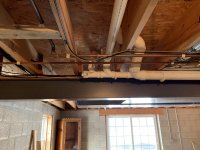To start off I hope that I am posting in the correct location for my problem. I am in the middle of installing a home water softener and now dealing with where to drain the tank discharge. The only option I see is (1) connecting to a 2" line from a bathroom tub that travels into the main line that goes into the septic tank. The (2) is to run a 3/4 or 1 " sch 40 over head and across my floor stringers to where my furnace and hot water discharge in the even of over flow.
The floor drain is connected to the inside French drains that lead out into a pond that also receives run off from storm drainage. As I see it these are the only 2 options I have I would like to hear others thought as to the best way of finishing my project.
The floor drain is connected to the inside French drains that lead out into a pond that also receives run off from storm drainage. As I see it these are the only 2 options I have I would like to hear others thought as to the best way of finishing my project.



